Insect & Disease Conditions Update
Mike Parisio joined the Entomology Lab in Augusta on May 29th and fills the position vacated by Allison Kanoti following her promotion to State Entomologist. He most recently served as a forest health specialist for the Vermont Department of Forests, Parks & Recreation in Rutland and before that, as a forest health specialist for the Minnesota Department of Natural Resources in Bemidji. He has experience with many of the forest insects affecting Maine and will be focusing on spruce budworm and forestry quarantines, among others. He grew up in the Catskill mountains of New York and holds a Master of Science degree in forest entomology from the State of New York College of Environmental Science and Forestry in Syracuse, where his graduate research focused on biological controls of emerald ash borer. Working for the Maine Forest Service has been a long-term goal of Mike’s, and we are happy to have him on board.
In our Forest Inventory Unit, Joseph Gendreau was hired on June 3rd to fill out the Northern Maine survey crew. He comes to us with a strong interest and working background in the forest and is a recent graduate of the University of Maine at Fort Kent. Joe is based out of Madawaska. Will Jeffries, who served on our inventory crew in Kingfield has accepted a position with the 30 Mile River Watershed Association. Will was a great addition to the team and will be missed.
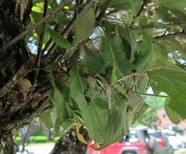
Browntail Moth (Euproctis chrysorrhoea) – The caterpillars have begun spinning cocoons to pupate in. We remind you that the cocoons, which can be found in sheltered areas such as on cars, boat trailers campers and eaves of houses as well as on the host tree leaves, are loaded with toxic hairs. The cocoons may contain multiple caterpillars/pupae and the toxic hairs that come along with them. It is also important to remember to check vehicles, camper, trailers, etc., for cocoons before you travel so you aren’t bringing them along for the ride. When possible, don’t park near infested trees, learn to recognize the cocoons and remove them if you find them. If you frequently travel between infested and uninfested areas, be on the lookout for signs you’ve taken this hitchhiker for a ride.
Image: Browntail pupal cocoon on Malus sp.
|
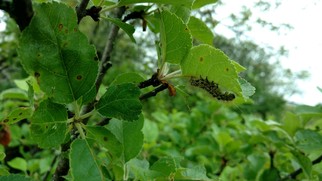
We have some good news from the field. In a few locations we are seeing collapses of browntail moth due to the fungus Entomophaga aulicae and possibly other pathogens. The Maine Forest Service is collaborating with University of Maine’s Dr. Ellie Groden and her graduate student Karla Boyd to characterize these outbreaks and tease apart what species the pathogen community surrounding browntail is comprised of. These fungal outbreaks were brought on by the wet spring conditions we had this past year. Towns where diseased caterpillars have been found include Bristol, Arrowsic, Whitefield, Jefferson parts of Camden, Turner, Harpswell, Brunswick and Wiscasset, as well as other towns. We’re not likely to see a statewide population collapse of browntail this year, however some areas have had temporary relief.
Image: E. aulicae infected browntail moth caterpillar in Turner.
Limiting outside lights at night during mid-July–August is good for many reasons, but if you need one more, it can help reduce the number of browntail moths to your area. Female browntail moths are attracted to lights and tend to hang out on host plants so a bug zapper will do no good. More information about how to recognize browntail moth and where we know it occurs can be found on our website.
|
Emerald Ash Borer (Agrilus planipennis) – The Maine Forest Service and cooperators have hung purple traps and girdled trees to monitor for the emerald ash borer (EAB). The results of some of our EAB surveys will begin to come in during July. In the meantime, we are responding to calls about possible EAB sightings. As of late June, EAB is emerging in southern Maine, although it will be well into July before they start to emerge in northern Aroostook. You can follow EAB emergence predictions at: https://www.usanpn.org/data/maps. Please keep your eyes open and collect any possible EAB you see, so that we can verify identification. Even if you need to gently step on something, please collect the remains, and we may be able to identify it.
During the last week of June, we will be releasing our first EAB parasitoids in Maine. Tetrastichus planipennisi is a larval parasitoid that has established well in other areas and has proven itself able to follow EAB infestations. It is very specific to EAB and should not pose a threat to native species in Maine. Because we found this EAB infestation fairly early, we hope that this parasitoid will establish well, and follow EAB as it spreads. Across the St. John River, on the New Brunswick side of this infestation, our Canadian neighbors are releasing the same species. We will continue to release Tetrastichus throughout the summer, and as additional species become available, we will be releasing two other parasitoids.
In southern Maine, suitable release sites have not been found. We are continuing to monitor the distribution of EAB, and when they are found, we plan to release parasitoids there as well.
Hemlock Woolly Adelgid (Adelges tsugae) – Hemlock woolly adelgid (HWA) was first detected in Harpswell in 2010. This spring, while on Birch Island in Harpswell, we noticed widespread severe decline and significant hemlock mortality in the southern areas of the island. It is likely that a few summers with drought conditions hastened this decline.
The tiny mobile crawlers of HWA are plentiful at this time of year. If you work in areas of infested hemlocks, you are almost guaranteed to leave with almost-invisible crawlers on your clothes, hair, vehicles and equipment. Crawlers can live for up to three weeks and, since there are no male HWA, it takes only one to travel with you to start a new infestation. Power-washing vehicles before contact with clean hemlock trees can reduce the number of crawlers and the chance of infesting a clean tree. By late July most crawlers have settled and the risk of spread by all but live plants is very limited.
Gypsy Moth (Lymantria dispar) – Gypsy moth populations have been low in Maine for years now, with 2019 showing the first signs of potential for an increase in population. Populations can roughly be tracked by counting the number of egg masses present on the oak trees in an area, which can then be used to make a prediction of the amount of damage in the upcoming year. One particular area of concern for 2019 is the town of Woolwich, with one site on State Route 127 having the potential for significant defoliation based on egg mass survey results.
A visit to this site in late June resulted in a pleasant surprise, with light defoliation limited to just a few trees in a stretch of about 0.2 miles of road edge surveyed. Although the egg masses were easily visible and very abundant, the number of caterpillars present on the nearby foliage and limbs does not indicate that the gypsy moth caterpillars at this site have had good survival in 2019. Those caterpillars present represented a broad spectrum of developmental stages, with a noticeable proportion appearing very small for this time of year. A cool spring may have delayed both emergence and growth rate, benefiting these trees another year. Some signs of disease were also found in the area, however not to a degree that would implicate this as the driving force behind the much lower-than-expected population size.
More information about gypsy moth in Maine can be found in our online factsheet: https://www.maine.gov/dacf/mfs/forest_health/insects/gypsy_moth.htm.

Winter Moth (Operophtera brumata) – This spring, MFS staff collected winter moth caterpillars from various sites along the southern coast of Maine to determine if prior releases of Cyzenis albicans, a parasitoid fly of winter moth, have led to their establishment. In June we collected caterpillars from Kittery, Cape Elizabeth, South Portland, Harpswell and Tenant’s harbor (with the help of Amy Palmer). These collections allow us to determine the rate of parasitism present in each population and to collect C. albicans for use in future biocontrol releases. C. albicans is very host specific and only parasitizes winter moth, leaving our native species alone. The collected winter moth pupae will be delivered to the Elkinton lab at University of Massachusetts to determine the rate of parasitism and will be returned to Maine in order to release them at a new site. We have received reports of severe winter moth defoliation in a few locations, mostly in the Midcoast region, with Boothbay Harbor being especially hard hit. At one of our previous release sites in South Portland, the homeowners have described a remarkable reduction in defoliation going from “strips of leaves” to the normal shot hole damage typical of lighter infestations. We are looking forward to carrying this biocontrol program into the future and the day that C. albicans is established throughout coastal Maine.
Image: Winter moth caterpillars in Kittery.
|

Forest Tent Caterpillar (Malacosoma disstria) – For the third year in a row, the entomology lab has received reports of extensive forest tent caterpillar defoliation along the Mines Rd in the town of Blue Hill. Once again, we expected quite a bit of current-year caterpillar activity from the sound of these reports, but all was surprisingly quiet when the site was checked in early June.
Image: Oak mortality along the Mines Road in Blue Hill
After locating the core damage area, this site visit began just like any other by looking and listening for the sights and sounds of an active forest tent caterpillar infestation. A close look at the forest floor however showed no evidence of damaged leaves dropped prematurely or leaf trimmings with tell-tale signs of caterpillar feeding. Although most trees were totally bare, some were still managing to push out small leaves, stunted and late but clearly not fed upon. The distinct sound of frass rain falling on the dry leaves on the forest floor was also missing. Finally, there were no signs of caterpillars or their lingering cocoons, sure to have been left behind and visible if the population had been large enough to cause this much damage in a single season.
What we see now is not new damage but the culmination of multiple years of severe defoliation paired with simultaneous drought, causing severe dieback and mortality of many mature oaks along the Mines Rd. In fact, Google Maps satellite imagery shows the extent of the damaged area quite well where the Mines Rd passes between Second and Third Ponds. Here and elsewhere, areas near lakeshores like this tend to be disproportionately affected by defoliators, likely owing to a favorable microclimate capable of supporting large caterpillar populations. Additionally, the north side of the Mines Rd, with its southern exposure, was also clearly much more severely affected than the south side of the road in this stretch. Although oaks are generally very resilient and able to withstand several years of defoliation or drought alone, the combined stress of both has proven too much in this case.
|

Oak Leaf Shothole Leafminer (Agromyza viridula) – In mid-June, the entomology lab received a large number of reports of oak leaves riddled with small holes. Although this type of damage could be confused with that of winter moth, several reports came from areas without large winter moth populations or any indication of winter moth caterpillars associated with the damage. Close examination of hole-ridden leaves determined this damage is being caused by oak leaf shothole leafminer, a little-known fly in the family Agromyzidae. While we do record this insect most years, damage appears to be more severe and widespread than usual in 2019. Interestingly, our colleagues in Massachusetts are reporting increased prevalence of this insect this year as well. Damage from oak leaf shothole leafminer has been reported in Androscoggin, Cumberland, Franklin, Kennebec, Knox, Lincoln, Oxford, Penobscot, Piscataquis, Somerset, Waldo, and York counties.
Image: Typical damage caused by oak leaf shothole leafminer on red oak.
Damage is caused during the spring as new leaves are emerging on both red and white oaks and does not become highly-visible until the leaves have reached nearly full size. While feeding, female flies perforate leaves with their ovipositors to consume plant fluids, resulting in numerous pinhole-sized injuries. As the leaves expand, so do these small areas of dead tissue, ultimately resulting in holes magnitudes larger than the originals. Additionally, a small amount of damage can also be caused by the leaf mining activities of the fly larvae, although this is much less frequently observed.
Despite the dramatic appearance of the damage, larger trees should be well-equipped to handle this light level of defoliation. Insight gathered from past records indicates this issue should resolve itself and there should be no need for management or intervention.
|
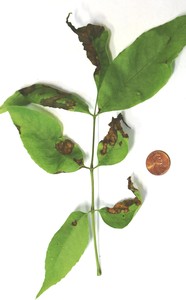
Anthracnose Diseases of Hardwoods – Anthracnose diseases have been frequently reported and encountered this spring. The higher level of anthracnose prevalence is due to 2019’s spring weather. The long periods of high moisture and cool weather have created perfect conditions for the increased prevalence of anthracnose diseases. Separate anthracnose species occur that are mostly specific to a certain host species. An exception was oak anthracnose observed on the leaves of planted chestnut trees in two separate locations in southern Maine. In these locations, nearby oaks were impacted similarly. Additionally, significant leaf deformation from oak anthracnose has been observed throughout Central and Southern Maine. Heavy defoliation from ash anthracnose has been reported Camden and Bath, while severe damage from sycamore anthracnose has been reported in Hallowell and Portland. Maple anthracnose and birch anthracnose prevalence is also expected to be higher this year, although few observations of these fungal leaf pathogens have been reported thus far. Trees heavily impacted by oak anthracnose in a single year are seldom severely impacted. In cases of heavy infection, and especially in ash, trees may drop their leaves and re-foliate. The re-foliated leaves of these trees are often smaller and the crowns less full. Trees with a high percentage of deformed leaves will also appear thin. Supplemental nutrients (fertilizer) can be applied following extensive leaf deformation and heavy defoliation to help trees recover.
Image: Ash anthracnose on white ash.
|
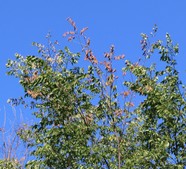
Dutch Elm Disease – Dutch elm disease symptoms have started to develop and can readily be seen on roadsides and field edges, where elms typically grow. While some seem to think elms are scarce in Maine due to the Dutch elm disease epidemic several decades ago, elms are fairly common and can still be found growing throughout the state. Wilting, discolored leaves than turn brown and brittle as they dry are typical signs of the disease. Symptoms are generally first seen in the upper portions of the crown advancing downward, usually killing a tree within a few years, but as little as one year if the disease is transferred via root connections from an adjacent infected tree.
Image: Wilting, discoloration and drying foliage of a Dutch elm disease-infected tree.
Late Frost Damage – Late frost has impacted a variety of hardwood species in several areas of Maine. Typically, this has occurred at higher elevations and geographic cold spots on the landscape during unseasonably cold nights in May. Damage to newly opened buds and expanding, succulent leaf tissues resulted in wilting followed by the leaf tissues becoming dark in color and drying, becoming very brittle. In most cases trees are expected to recover and set new buds.
|
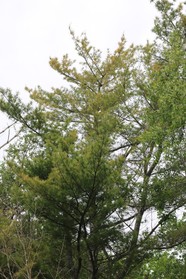
White Pine Needle Cast and Needle Blight – The white pine needle diseases (WPND) complex that has been impacting white pine trees for more than 10 years has continued in spring 2019 across Maine’s white pine resource. Needle discoloration and losses are resulting in an increasing number of disease clinic requests for assistance, a trend expected to continue into July by which time most needles will have been shed, leaving only current-year needles and thin-looking crowns. This is different from the natural fall needle drop typical of healthy pines. It is important to realize that the symptoms we are seeing this early summer are the result of infections during prolonged wet weather in spring of last year. Thus, due to the wetter than normal weather this spring, severe needle cast symptoms are already expected for this time next year. Brown spot needle blight, Mycosphaerella dearnessii / Lecanosticta acicola, is most frequently associated with yellowing symptoms and defoliation in Maine. It was the most common needle disease recorded in Maine during the USFS-supported 2018 eastern white pine health assessment (confirmed at 25 of 37 sites). Dooks needle blight (Lophophacidium dooksii / Canavirgella banfieldii), Bifusella linearis and Septorioides strobi (these last two diseases have no common name) are also found and are responsible for discoloration and needle cast symptoms. Due to the mostly consistent disease levels over the past years, the implications of this chronic stress and possible mortality remain a concern. Continued monitoring of this situation will be prioritized for early detection of any emerging insect or disease agents that could serve as further factors leading to white pine decline and mortality.
Image: White pine heavily infected with brown spot needle blight showing and shedding yellowing needles in June.
|
July 29th, 2019- 9am to Noon. Androscoggin Valley SWCD is providing an Invasive Forest Pests Workshop, at UMAINE Cooperative Extension, 24 Maine street, Lisbon Falls, ME. Free. Call 207-241-5377 to register. Or email at info@androscogginswcd.org.
Office hours are 7:30 am to 4:00 pm, Monday through Friday, except for holidays. If you plan to visit either office, you may wish to call ahead just to make sure someone will be present to meet with you (207) 287-2431.
Conditions Report No. 3, 2019
On-line: https://www.maine.gov/dacf/mfs/publications/condition_reports.html
Department of Agriculture Conservation & Forestry
Maine Forest Service – Forest Health and Monitoring
Contributors: Aaron Bergdahl, Allison Kanoti, Mike Parisio, Thomas Schmeelk, and Colleen Teerling
Unless otherwise noted, photos by Maine Forest Service, DACF
|